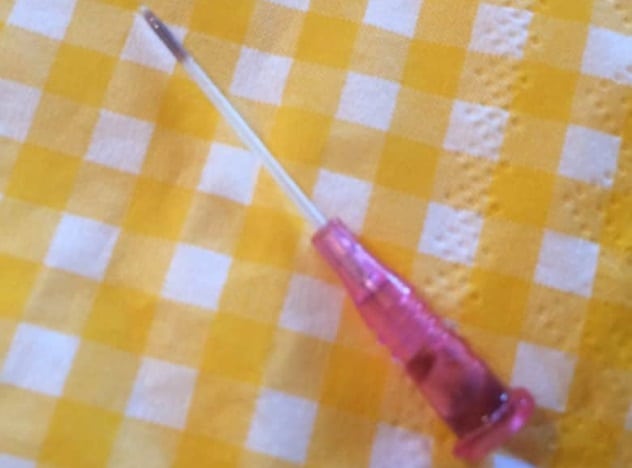 Mysteries
Mysteries  Mysteries
Mysteries  History
History 10 Surprising Stories About the Texas Rangers
 Humans
Humans 10 Philosophers Who Were Driven Mad by Their Own Theories
 Miscellaneous
Miscellaneous 10 Video-Game-Worthy Weapons and Armors from History
 Weird Stuff
Weird Stuff 10 Psychics Who Accurately Predicted Wartime Events
 The Arts
The Arts 10 Pieces of Art Inspired by a Broken Heart
 Health
Health 10 Science Fiction-Sounding New Medical Treatments
 History
History 10 Surprising Facts About the Father of Submarine Warfare
 Space
Space Ten Astonishing New Insights into Alien Worlds
 Weird Stuff
Weird Stuff 10 Bizarre Summer Solstice Rituals Still Practiced Today
 Mysteries
Mysteries Top 10 Haunting Facts About the Ghost Ship MV Alta
 History
History 10 Surprising Stories About the Texas Rangers
 Humans
Humans 10 Philosophers Who Were Driven Mad by Their Own Theories
Who's Behind Listverse?

Jamie Frater
Head Editor
Jamie founded Listverse due to an insatiable desire to share fascinating, obscure, and bizarre facts. He has been a guest speaker on numerous national radio and television stations and is a five time published author.
More About Us Miscellaneous
Miscellaneous 10 Video-Game-Worthy Weapons and Armors from History
 Weird Stuff
Weird Stuff 10 Psychics Who Accurately Predicted Wartime Events
 The Arts
The Arts 10 Pieces of Art Inspired by a Broken Heart
 Health
Health 10 Science Fiction-Sounding New Medical Treatments
 History
History 10 Surprising Facts About the Father of Submarine Warfare
 Space
Space Ten Astonishing New Insights into Alien Worlds
 Weird Stuff
Weird Stuff 10 Bizarre Summer Solstice Rituals Still Practiced Today
Top 10 Painful Facts And Calamities Involving Urinary Catheters
Urinary catheters are used for various medical conditions in order drain urine from the bladder when other means have failed. This medical device is never ideal for any man or woman, to say the least. The use of urinary catheters is painful, not to mention rather unflattering.
The following ten entries focus on intriguing facts, medical mishaps, and profound consequences too absurd and grotesque for one to comprehend or imagine. Suffice it to say, you really don’t want to ever be catheterized.
10 Ben Franklin

Catheters date back to as early as 3000 BC, when the materials used brought about pain reminiscent of medieval torture. From straw and rolled up palm leaves to gold, silver, copper, brass, and lead, anything that could form a thin, hollowed shape was used. Understandably, these were far from ideal when it came to shoving them up your urethra. Interestingly enough, one of the pioneers to revolutionize the wonderfully agonizing world of catheterization was none other than one of the United States’ famous Founding Fathers, Benjamin Franklin.
On a daily basis, Franklin witnessed his brother John go through the arduous task of placing a “bulky metal catheter” into his bladder. John had a history of kidney stones; thus, self-catheterization became an excruciating daily ritual, one in which Franklin wished to remedy. Working with his local silversmith, Franklin designed a flexible catheter using silver which could bend to any desired shape. In addition, Franklin had holes inserted throughout the sides of the catheter that allowed for a more proficient drainage of urine. Writing to his brother, Franklin noted, “It is as flexible as would be expected in a thing of the kind, and I imagine will readily comply with the turns of the passage.”
By improving on the conventional catheters of the time, Ben Franklin drastically decreased the discomfort for not only his brother but for future generations to come.[1]
9 Male Versus Female Catheters

As one might imagine, Foley catheters differ between men and women due to the dissimilar anatomical length of urethrae. Specifically, male patients require a lengthier tube, ranging from 40 to 45 centimeters (16–18 in), whereas females range from 20 to 26 centimeters (8–10 in). It doesn’t take a genius to understand that if a male patient has a female catheter inserted, it would not reach the bladder, thus potentially resulting in urine retention and severe trauma. As crazy as it may sound, nurses and physicians have continuously made such detrimental errors despite all their education and training.
Case in point, health care providers in the UK were alerted, or perhaps reminded, about the risks of inserting female catheters into male patients. The National Patient Safety Agency (NPSA) reported an appalling 114 incidents of accidental insertions from 2006 to 2008, leading to unfathomable consequences. Aside from significant pain—which is putting it mildly—severe hemorrhaging (bleeding) has been an injurious factor. Sadly, heavy bleeding led to the death of a male patient in January 2006 following a minuscule procedure. As noted earlier, urinary retention can easily occur, leading to kidney failure and death.[2]
8 Laziness, Forgetfulness, And Greed

As we have previously seen, negligence pertaining to catheters is not only injurious to the patient but life-threatening, as well. Even more appalling is the fact that 31 percent of hospitalized patients who receive Foley catheters don’t even require them, according to the American Journal of Medicine. This begs the question as to why patients are continuously catheterized in the first place. The answer is not only inexcusable but nefarious: laziness, pure and simple. Subjecting a patient to a catheter decreases soiled sheets, making the job easier for nursing staff.
What is often forgotten is that the devices have a life span and, for the most part, are left in far too long. This factor leads to urinary tract infections, hence longer hospital stays. Aside from casting complete blame on nurses, researchers have found that doctors often forget or don’t even know that their patient has an indwelling catheter. In a survey of 256 physicians from across the United States, 28 percent have claimed to have made this error. Interestingly enough, Dr. Martin Resnick, urologist and secretary of the American Urology Association, stated that “patients have to become more engaged” with their physician.[3]
According to Mandy Fader, a professor at the University of Southampton, evidence shows that catheters are overused and outdated, with a design that has changed “very little” in 80 years. This shocking fact stems from “low investments from industry and weak regulation.” Fader concludes that the devices are merely “easy money,” with manufacturers dismissing innovation and improvement for a state-of-the-art commonplace product.
7 Scrumptious Souvenir

In 2017, while celebrating the birth of a baby boy, family members in Quebec gathered around for dessert before parting ways for the evening. Without hesitation, the joyous group began devouring a tub of Coaticook’s pecan ice cream flavored with chocolate, caramel, and a particularly special ingredient: a catheter. Clearly, the family was a tad perturbed—but not as much as the grandfather, who had nearly swallowed the hidden gem before spitting out his new keepsake. Though it’s not clear if the catheter had ever been used, questions arose as to whether a dark tip on the medical device was caramel or blood. As a precaution, the grandfather, who is “not even able to speak about it,” along with other family members, were informed by health officials that they would need to be tested every six months for HIV as well as hepatitis A, B, and C.[4]
The Canadian Food Inspection Agency (CFIA) conducted a two-day investigation at the ice cream company’s facility, Laiterie de Coaticook. Following their investigation, the CFIA concluded that there was no evidence that the catheter had originated from the company’s factory. Nonetheless, the investigation continued with the CFIA and the Quebec Ministry of Agriculture in order to prevent any future tasty souvenirs.
6 Reasonable Doubt

For plaintiffs, lawsuits pertaining to medical malpractice can be exceptionally difficult to win, given the hurdles of proving wrongdoing and negligence. Often, courts side with the defense due to these obstacles, despite injuries incurred. Such was the case for Felix Casaceli, who, in March 2009, underwent surgery following the fracture of his right heel in a snowboarding accident.
While under general anesthesia, a Foley catheter was inserted into his penis as part of the sterility process. It was alleged that Casaceli’s nurse erroneously placed lubricating numbing gel into the balloon of the catheter instead of sterile water. In addition, the balloon was inflated prior to reaching Casaceli’s bladder, expanding his urethra during inflation. Now, just imagine a clown blowing up a child’s balloon and envision that happening in your urethra. Get the picture? When the catheter was eventually removed in a traumatic fashion, the soft tissue, muscles, and nerves of Casaceli’s penis were permanently damaged, resulting in incontinence. Undoubtedly, this is a man’s worst nightmare aside from castration.[5]
A similar incident occurred in July 2007 following spinal surgery. Russell Baker, 35, claims to have suffered irreparable nerve damage to his penis, leading to erectile dysfunction and interfering with his marital relations. In fact, Baker’s wife sought damages for loss of their bedroom acrobatics, claiming that she and her husband (who were newlyweds) previously had intercourse up to “three times a day.” Despite Baker and Casaceli filing lawsuits, both parties lost their case. In the end, the plaintiffs could not prove wrongdoing or that permanent injury had taken place, so the jury ruled no cause of action, leaving the men sullen and limp.
5 A Horror Scene

The unsightly scene for the following case is as rare as it is grotesque. Presenting with urinary retention, a 72-year-old woman was admitted to the hospital for treatment and observation. Following the placement of an indwelling Foley catheter to relieve the retention, her prognosis was promising. That all changed in a moment’s notice the following day, when the unthinkable occurred.
The elderly woman, for unknown reasons, reached down to the tube and began to forcefully pull the device out. It is speculated that confusion due to her senility played a role in her actions. Regardless, what would follow presented an image reminiscent of a horror film. When the medical staff checked on her, her bladder and uterus were protruding. Specifically, the strength at which she pulled caused her bladder to turn inside out as it prolapsed outside of her body, concurrent with her uterus. Doctor’s described the horrifying scene as “a red edematous, slimy, pyriform mass 6 cm in diameter sitting over the completely prolapsed uterus.”
These cases are particularly rare and quite complicated to remedy. With her life hanging on by mere minutes, surgeons went to work. With a generous amount of xylocaine jelly, physicians were able to manually ease the bladder back through her urethra, followed by definite corrective surgery for the protruding uterus. In spite of both procedures being a success, the woman’s long-term outcome is uncertain.[6]
4 Recycling At Its Finest

It may come as an unsettling surprise that aside from urinary catheters, anal catheters exist as well. Let that sink in—no pun intended—for just a moment. The purpose of the penetrating device is to either inject fluids or obtain fecal matter samples. One would imagine that the insertion of an anal catheter would be an incredibly unpleasant experience, but a colorectal surgeon in New Jersey took “disgusting” to a whole new level.
According to the New Jersey Board of Medical Examiners, Dr. Sanjiv K. Patankar was continuously reusing disposable, single-use anal catheters on his patients. Out of 82 anal probes conducted by Dr. Patankar between January and November 2017, only five catheters were used, averaging 16 people per catheter. Afterward, the unscrupulous physician ordered his obedient staff to the romantic and fragrant duty of washing the feces-covered tubes between uses, potentially exposing his patients to infectious diseases.
This inevitably led to legal troubles for Dr. Patankar, with Attorney General Christopher Porrino condemning his actions, stating: “It is appalling that a doctor would engage in such an unsanitary and dangerous practice. Through his alleged conduct, Dr. Patankar has demonstrated a reckless disregard for public safety that placed countless patients at risk of communicable diseases.”
Dr. Patankar’s license to practice medicine was revoked by the State Board of Medical Examiners in January 2018. However, he will have the right to reapply after 42 months. As for the 82 patients Dr. Jekyll generously put in harm’s way, state health officials are urging them to consider getting tested for a range of diseases.[7]
3 A Man’s Worst Nightmare

Speaking of the various types of catheters aside from the typical indwelling Foley, there are also non-penetrating external or “condom” catheters. As one could imagine, the catheter fits over the penis, collecting a man’s urine while decreasing the risk of urinary tract infections (UTIs) by up to 80 percent. Clearly, men who qualify for the medical device (short-term incontinence, patients without urinary retention or obstruction, etc.) praise the more pleasant and painless flexible sheath.
In spite of the countless benefits condom catheters afford, they are not without their flaws. One case in particular pulls at the heartstrings of men all over the world. Following an accident, a 75-year-old male was admitted to the emergency department and fitted with a condom catheter due to his urinary incontinence. After he was stabilized and discharged, the elderly gentleman was permitted to take his new external device home.
Two weeks later, he returned to the hospital complaining of swelling and discoloration of his penis. Evidently, the adhesive tape used to secure the catheter acted more as a tourniquet, cutting off the blood flow to his penile arteries. Upon examination, there were no pulsations or sensation, due to the fact that gangrene had developed. As a result of the irreversible damage the gangrene inflicted, there was no other choice but to surgically amputate the entirety of his penis. After the horrendous surgery, the man was reported to be doing well, at least medically speaking.[8]
2 ‘Whatcha Gonna Do When They Come For You?’

When police in Pierre, South Dakota, ask you to provide a urine sample, you’d better oblige or be prepared to face the consequences. In March 2016, police were responding to a domestic disturbance at the home of Dirk Sparks, whom they described as acting “fidgety.” Upon asking for a urine sample, Sparks justifiably refused, as was his right without a warrant. As luck would have it, a warrant was issued hours later, leading to Sparks being handcuffed and pinned down to a hospital exam table. With his pants pulled down, Sparks continued to believe their antics were merely a threat; that is until the searing pain of a pencil-sized tube shoved up his urethra took him by surprise.
Interestingly enough, the Pierre Police Department has quite the reputation of forced catheterization. In February 2017, a three-year-old boy was forcibly catheterized after authorities found that the mother’s boyfriend failed a drug screen, possibly exposing the child. When the boy could not produce urine to determine if narcotics were in his system, authorities in Pierre did what they knew best. “They just shoved it right up there, and he screamed so bad,” the boy’s mother, Kristen Hunter, said. “He’s still dealing with a staph infection, and we are still giving him medication.”
Such was also the case with 34-year-old Jason Riis, who failed a field sobriety test in March 2016. To add insult to injury, Riis agreed to provide a urine sample but was informed that his option of doing so had passed. “One cop held my penis, and a doctor shoved a catheter in me,” Riis said. “It hurt for a week. I couldn’t pee.” The moral of the story is don’t get arrested in Pierre, South Dakota, if you value a painless and steady stream.[9]
1 Bursting Bladder

For some, being admitted to a hospital is deemed a death sentence. Such was the case for a former member of the Australian national soccer team, 72-year-old Steven Herczeg, when he entered Adelaide’s Queen Elizabeth Hospital in September 2016. Soon after his admission, a Foley catheter was inserted. However, it was wrongly connected to none other than an oxygen tank. As the minutes passed, the air began to fill Herczeg’s bladder, causing the organ to expand to the point of eruption. Nurses became aware of the inconceivable mishap only after his screams of pain echoed through the ward. In spite of issuing a code blue with immediate medical attention, the gases had expanded into his abdomen, causing his lungs to collapse from the pressure. Within minutes, Herczeg was dead, and the hospital staff was in a panic.
Upon questioning, a nurse recalled “seeing a white connector between the green oxygen tube and the brown catheter,” but claimed that she did not know what either was for. Such an asinine error is difficult to imagine for a medical “professional,” especially an indwelling tube in the man’s penis. To make matters worse for the hospital’s dwindling reputation, the urinary catheter and oxygen tubing were conveniently destroyed before investigators could inspect them.[10]
Adam is just a hubcap trying to hold on in the fast lane.
Read about more cringe-inducing medical practices on Top 10 Medical Treatments Worse Than Their Horrifying Diseases and 10 Barbaric Medical Procedures Still Practiced Today.








